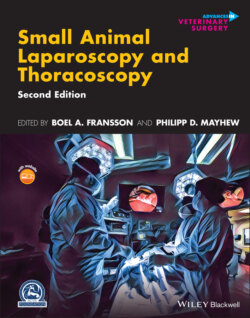Читать книгу Small Animal Laparoscopy and Thoracoscopy - Группа авторов - Страница 54
Cannula Placement
ОглавлениеA fundamental difference between laparoscopic and open suturing is the restricted instrument mobility. The surgeon is confined by the cannula placement to a single arc of rotation perpendicular to the axis of the instrument. The cannula placement has to be as ideal as possible to make suturing easier. Figure 2.10 depicts the ideal cannula placement for knot tying. However, small animal surgeons often have to compromise on the classical triangulation due to animal size, and if suturing is done bilaterally.
Figure 2.10 Classical cannula triangulation to optimize instrument angles and working distances for laparoscopic knot tying and suturing.
An intercannula distance of at least 5 cm is desirable for the needle driver and accessory instrument. The working tips of these instruments should meet at oblique angles with each other at a relatively wide angle of 60° or more. If possible, the cannula for the right needle driver should be parallel to the suture line. The distance between cannula entrance and operative field should be approximately half of the length of the instrument (e.g., for 30‐cm instruments, the cannula should be placed 15 cm [∼6 in.] from the target field) [2]. The instruments and camera need to be directed in the same axis as the surgeon's view toward the screen to avoid mirrored vision.
